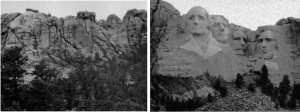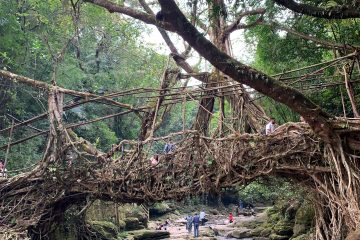Re-storying Metaphors as Decolonization
By Daniel Bryan

In their seminal article, “Decolonization is not a metaphor,” Eve Tuck and K. Wayne Yang speak to many of us who read this blog, calling for activist scholars, educators, and organizers to reconsider adopting the words “decolonizing” and “decolonization” in their vital work in social justice. Their argument is sound: decolonization is about the “repatriation of Indigenous land and life” (p. 21), and any efforts that use the words for other means, no matter the intentions, re-center whiteness in the activism. Their words have never resonated with me more deeply than on July 3rd when the US President stood in front of Mount Rushmore to celebrate the country’s independence. Yet, as that event drew me to think about the article, I could not shake the metaphorical significance of the moment, and I became evermore curious about the role of metaphors in decolonization. While I agree that decolonization is not a metaphor, I argue that it is also impossible without metaphor.
All humans are storytellers, as well as story-makers. Each one of our stories is a metaphor (containing additional metaphors within) that represents our lived reality, or at least a perceived lived reality. We are constantly reinventing our reality through this narrative form of representation, sometimes actively, but most often as passive consumers of others’ stories. When we consciously appropriate the power of stories to collectively reimagine our world, we turn the word story into a verb. We “story” our world. Many of us who read this blog witness a system founded on unjust stories and our life’s work is committed to “re-storying” our world. I turn back to the July 3rd Mount Rushmore event to explore “storying” and “re-storying” as vital tools for decolonization.
On Lakota lands, in front of the Black Hills mountain defaced with gargantuan white faces, the President praised four “American giants” as “gallant men whose intrepid deeds unleashed the greatest leap of human advancement the world has ever known,” while Harold Frazier of the Cheyenne River Sioux Tribe viewed the four faces differently, bluntly referring to them as a “brand on our flesh.” Our storytelling minds can convert these conflicting metaphors into one representing the colonial story: “American giants…a brand on our flesh.”
Reading these words can provoke powerful conversations and learning opportunities about the history of white supremacy and the importance of repatriation, which many of us hope will lead to changes in behaviors and actions that eventually results in decolonization. Here we see metaphor playing a role; however, this process only partially takes advantage of the potential of metaphors. It still feels distant and objectifying. If we want to re-story our world in a more active and engaged manner, working as allies with Indigenous peoples, then we must work to collectively embody the metaphors.
Embodying metaphors refers to creating knowledge from and with the body, understanding our bodies as the living-breathing vessel with which we relate to the world and as the context from which we can better know the world. To do this, we need to remind ourselves that we are all creative beings; maybe not professionally, but we are all dancers, actors, artists, etc. Embodiment accepts sensing and feeling the story as a way of knowing. We do not just read or hear “American giants” as a “brand on our flesh” and try to rationalize those images as part of the struggle. Rather, it is as if those words ignite movement within our bodies, almost like a dance, and we sense how they become part of us. Think of yourself standing in front of Mount Rushmore and mirroring the story of that mountain through a dance, an enacted scene, or simply a meditation. The mountains become our flesh and we feel our bodies being chipped away and our skin being skillfully stripped until four white male faces are branded on our arms. How does it feel to be branded? What does it mean to walk around with these imprints? In what ways do our feelings evolve over time? And how does the story change when the President tells us those brands are “American giants” and their presence on our bodies is indicative of “the greatest leap of human advancement the world has ever known?”
When we truly make ourselves vulnerable to the stories of colonization, our role in decolonization becomes clearer. We are here to tell burning stories about the terrible acts of violence committed against lands and people with the goal of returning life and land to the people. We tell them with the urgency someone feels whose body has been branded against their will. We know that our stories are not synonymous with decolonization and that the lands and lives are not ours to be regained, but we also know that decolonization means more than bringing down the “American giants” from Mount Rushmore. Decolonization is the restorying of the “American” story, but that will only happen if we develop a consciousness of how those stories have manipulated our imaginations and social systems. Decolonization is not a metaphor, but the metaphors are certainly its most powerful weapon.
#
Daniel Bryan is an educator, activist, and artist. He is the co-founder and Director of the Pachaysana Institute, a non-profit educational organization dedicated to community-based, fair-trade, intercultural education programs in Ecuador.
Counterpoint blogs may be reprinted with the following acknowledgement: “This article was published by Counterpoint Navigating Knowledge on 28 July 2020.”
The views and opinions expressed on this website, in its publications, and in comments made in response to the site and publications are those of the author(s) and do not necessarily reflect the views and opinions of Counterpoint: Navigating Knowledge, its founders, its staff, or any agent or institution affiliated with it, nor those of the institution(s) with which the author is affiliated. Counterpoint exists to promote vigorous debate within and across knowledge systems and therefore publishes a wide variety of views and opinions in the interests of open conversation and dialogue.



